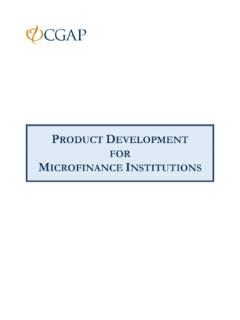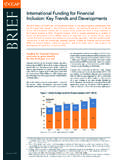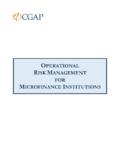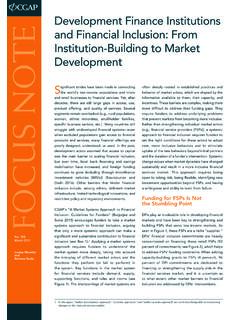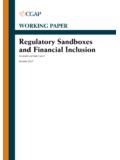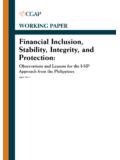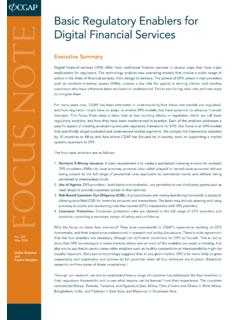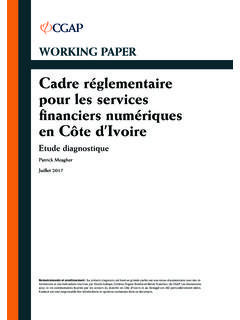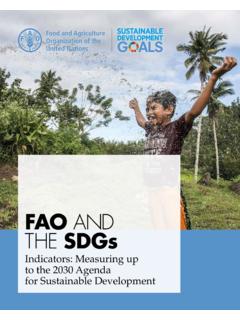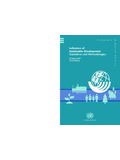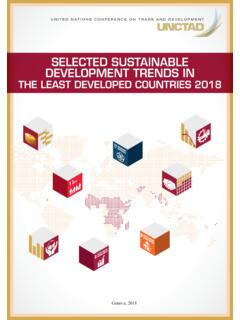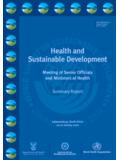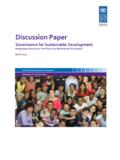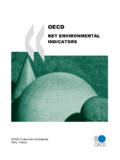Transcription of Achieving the Sustainable Development Goals - …
1 Achieving the Sustainable Development Goals The Role of Financial Inclusion Leora Klapper, Mayada El-Zoghbi, and Jake Hess Achieving financial inclusion is not an end in itself. It's the means to an end. Queen M xima of the Netherlands/UNSGSA. APRIL. 2016. Achieving the Sustainable Development Goals : The Role of Financial Inclusion CGAP, 2016. 1825 I Street NW, 7th Floor Washington, DC 20006. All publications are available online at Table of Contents Message from the UNSGSA .. iv I. Introduction .. 1. II. Research Shows Access to Financial Services Can Help Achieve the SDG Goals .. 2. A. Eliminating extreme poverty (SDG 1) .. 2. B. Reducing hunger and promoting food security (SDG 2) .. 4. C. Achieving good health and well-being (SDG 3) .. 4. D. Fostering quality education (SDG 4) .. 5. E. Promoting gender equality (SDG 5) .. 6. III. Access to Infrastructure: Water and Sanitation (SDG 6) and Energy (SDG 7).
2 7. IV. Achieving Broader Economic and Social Goals .. 7. A. Promoting shared economic growth (SDG 8) .. 7. B. Promoting innovation and Sustainable industrialization (SDG 9) .. 8. C. Toward equitable and peaceful societies (SDG 10 and SDG 16) .. 9. V. Conclusion .. 9. VI. References .. 11. Achieving the Sustainable Development Goals : The Role of Financial Inclusion iii. Message from the UNSGSA. In my role as the UN Secretary General's Special Advocate for Inclusive Finance for Development , I have participated, along with my partners, in many of the global discussions that have led to the Sustainable Development Goals (SDGs). Throughout this member state driven process, governments and Development practitioners have painstakingly worked to set priorities and articulate a vision for where we all want to see the world by 2030. There is no doubt that we have the means to achieve this vision by making some important policy and implementation choices.
3 Investing in financial inclusion is certainly one of them. The evidence presented in this paper is powerful: it gathers in one convenient place the increasingly clear link between financial inclusion and Development . It identifies where financial inclusion may have a direct impact on outcomes such as health, education, and gender equality. It also lays out the evidence for the channels in which financial inclusion has an indirect role in Achieving broader Goals such as inequality, growth, and peace. Furthermore, this paper shows us that we can do more to continue to build the evidence base where it is not yet available. Viewed from the angle of the SDGs, this paper reinforces that financial inclusion is about human Development and empowerment. Financial inclusion gives people the means to improve their own lives. It can be clearly observed in the choices that women have as a result of having access to a bank account: they invest in businesses and use proceeds from their businesses to invest in their households.
4 It becomes apparent in the choices that families make for their children's education when they can save or receive remittances from family members living abroad. And, it is obvious in the choices that farmers make in the types of crops they produce and the resulting increase in crop production when farmers are given appropriate financial products, like commitment savings products and weather-based index insurance. But financial inclusion carries benefits even beyond the improvement in individual lives. By moving away from cash and using digital payments to distribute government wages and cash transfers such as pensions, governments can cut costs and reduce leakage. Digitizing social transfers and government wages has the potential to introduce millions of adults in emerging economies into the financial system. This has many positive ripple effects on the broader financial system. I am deeply impressed by the progress the global community has made in recent years to advance financial inclusion.
5 But with 2 billion people still excluded from the formal financial system, I remain humbled by the work ahead of us. We must keep in mind that financial inclusion is not an end in and of itself but an important enabler of Development progress and a powerful tool to reach our main goal: Achieving the SDGs. Research such as the work presented in this paper helps us to understand the challenges ahead while shining light on the best path forward. I offer much gratitude to the organizations involved in the paper, and I also call on researchers and the global community to continue to build the knowledge base related to the Development impact of financial inclusion so that we can adapt our policy recommendations. Finally, I would like to thank the member organizations of my Reference Group that have laid the groundwork for this paper, including CGAP, the World Bank, the Bill & Melinda Gates Foundation, and UNCDF.
6 And special thanks goes to the authors of the paper, Leora Klapper, Mayada El-Zoghbi, and Jake Hess. Her Majesty Queen M xima of the Netherlands United Nations Secretary-General's Special Advocate for Inclusive Finance for Development iv Achieving the Sustainable Development Goals : The Role of Financial Inclusion I. Introduction On 25 September 2015, the United Nations General Assembly adopted the 2030 Agenda for Sustainable Development , along with a new set of Development Goals that are collectively called the Sustainable Development Goals (SDGs). The Agenda is a culmination of many years of negotiation and was endorsed by all 193 member- nations of the General Assembly, both developed and developing and applies to all countries. UN Secretary General Ban Ki-Moon noted that the new agenda is a promise by leaders to all people everywhere. It is an agenda for people, to end poverty in all of its forms an agenda for the planet, our common home.
7 The SDGs comprise an ambitious 17 Goals (see Figure 1). While the SDGs do not explicitly target financial inclusion, greater access to financial services is a key enabler for many of them. By reviewing the research on the link between financial inclusion and Development , this working paper shows where and how financial services can help achieve the SDGs. It concludes by outlining opportunities for businesses and governments to expand financial inclusion in emerging countries by digitizing cash payments of wages and transfers. Financial inclusion means that formal financial services such as deposit and savings accounts, payment services, loans, and insurance are readily available to consumers and that they are actively and effectively using these services to meet their specific needs (GPFI 2011). A related but distinct concept is financial Development . While financial inclusion is typically measured by gauging how many people own and use formal financial products, financial Development is concerned with macro-level indicators, such as the size of the stock market and a country's ratio of credit to gross domestic product (GDP).
8 Many factors influence both a country's level of financial inclusion and financial Development , including income per capita, good governance, the quality of institutions, availability of information, and the regulatory environment (Allen et al. 2016; Rojas-Suarez and Gonzales 2010;. Karlan et al. 2014; Park and Mercado 2015). Figure 1: Sustainable Development Goals Source: Achieving the Sustainable Development Goals : The Role of Financial Inclusion 1. The very first SDG ending extreme poverty explicitly mentions the importance of access to financial services. When people are included in the financial system, they are better able to climb out of poverty by investing in business or education. In India, a government effort to open banks in rural areas helped cut rural poverty by 14. to 17 percentage points. Spending on school-related expenses increased by 20 percent in Nepali households that opened free bank accounts.
9 Financial inclusion also prevents people from falling into poverty by softening the blow of unexpected expenses. When hit with the death of a breadwinner, a savings account can be all that stands between a family's impoverishment and stability. Digital payment services also allow people to collect money from far-flung friends and relatives when faced with economic pressure. Increasing account ownership among the world's 2 billion unbanked adults most of whom are poor women . would help the SDGs promote gender equality. In Kenya, women who had savings accounts invested 45 percent more in their businesses and were less likely to sell off assets when faced with a health emergency. Access to financial services also can result in higher spending on health and other necessities. One study in Kenya found that health expenditures increased by 66 percent when people were provided with a safe space to keep money.
10 Financial inclusion of farmers can lead to bigger investments in the planting season, resulting in higher yields . and hence progress toward SDG 2, which focuses on improving food security. When Malawian farmers had their earnings directly deposited into a new bank account, they spent 13 percent more money on equipment and increased the value of their crop output by 21 percent. Rainfall insurance, which kicks in when there is a drought or flood, also has been shown to embolden farmers to make riskier and more lucrative investments. The links between financial inclusion and other SDGs are not as well established. SDG 9, which calls for business innovation, might be served by wider access to credit. Entrepreneurs often use microloans to increase investments in small businesses, but microcredit has not turned out to be the engine of innovation many once hoped it would be. Nor is there strong evidence that financial inclusion directly reduces inequality within and among countries (SDG 10) or leads to inclusive economic growth on the national level (SDG 8).
